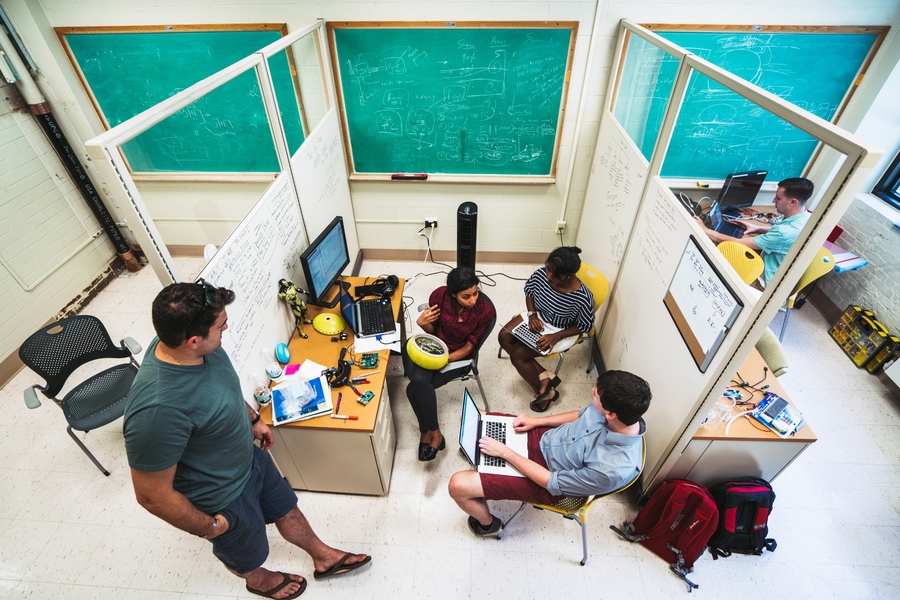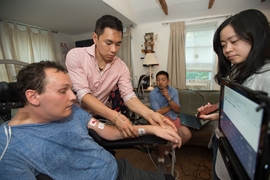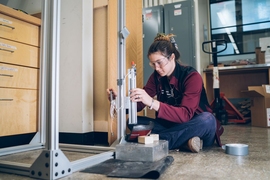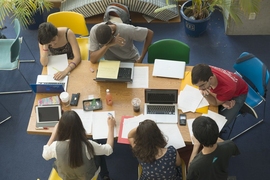Classes may not be meeting, but MIT students aren’t letting their new ideas about mapping the ocean, advancing biological studies, and improving agricultural production sit idle. Participants in the MIT Sandbox Innovation Fund, an Institute-wide program launched in January by the School of Engineering, are hard at work.
The evolving spirit of the Sandbox program is best captured by taking a closer look at what people involved have been up to this summer:
A space to create
The summer headquarters of Hydroswarm is a room on the third floor of Building 24. Because of campus improvements, the elevator is out of commission for the summer, and the air conditioning is erratic. Sampriti Bhattacharya, the high-energy founder of the company, is unfazed. The room’s chalkboards are scrawled with formulas, lists, and cost estimates, which mostly involve the start-up she is working on with her colleagues. Alongside those notes are to-dos for Bhattacharya’s PhD work in mechanical engineering.
Bhattacharya designed an underwater drone as part of her thesis — and, in 2015, transformed that research into a prototype that has inspired enthusiasm from top industry players and the Department of Defense, and, most recently, a prestigious international museum that she is hesitant to name before it publicly announces that her creation will be featured early next year as a design of the future.
For Bhattacharya, a workspace at MIT, which was arranged for her by the Sandbox program after she and her team secured $10,000 in funding at the program’s funding board meeting in April, has been pivotal. No matter that it’s a relatively small room with makeshift cubicles and table fans in lieu of air conditioning — those in the space, including Hydroswarm’s project manager Jon Burton and several interns, are “doing amazing stuff.” The key thing, she says, is being on campus. “It’s the best to be able to shuffle between doing my PhD research at the lab and working on our prototypes at Hydroswarm,” she says. “This office space is like one of the best things we got from the program.”
Innovation for its own sake
People are at different stages within the Sandbox world. In some cases, teams are keeping a near-total focus on innovating for its own sake. Entrepreneurship, if it happens, is a distant and distracting thought — as in the case of Francis Lee and the rest of the BioDomus team, a collaboration between graduate students in the Department of Biological Engineering and Health Sciences and Technology program at MIT.
On an afternoon in July, Lee took a short break from his work to discuss their project, which involves building bioreactors for cell culture. He and the others are currently developing libraries of code and hardware parts, which will enable them to prototype different reactors. “We’re basically exploring a concept. We just want to see what comes out of it,” he says of BioDomus, which received the maximum $25,000 in funding from Sandbox.
Lee, a research associate at the MIT Synthetic Biology Center, says the team primarily works there or at the MIT Lincoln Laboratory Beaver Works Center. They gather at night because their day schedules vary too much. “We all tend to work different hours. So we see a lot of each other at night.”
The social side
Sandbox Executive Director Jinane Abounadi SM ’90, PhD ’98, who previously worked at two Boston-based startups, ITA and Kayak, understands the value of hard work — and taking breaks. With energy, humor, and persistence, she draws Sandbox teams, advisors, and board members out to small social events where they can experience the kind of learning that happens best in groups.
At a July volleyball game and August barbecue, teams and visitors hang out and learn more about each other. Ammar El Seed, co-founder of BitSence, a group of system architects, engineers, software developers, and product managers who are working to help cities and businesses deliver better services to citizens in public spaces by collecting data on environmental conditions and human activity in those spaces, says the events present “a great chance to meet the other teams.”
Students also had a chance to chat with influential people, such as Ignacio Bobillo, managing director of international business sevelopment at World Energy, and Brian Rosnov MBA ’14, head of the Philips Digital Accelerator in Cambridge, a founding corporate sponsor of Sandbox.
The social events aren’t just about team sports, hamburgers, and cold drinks however. BitSence presented their ideas to industry experts before the barbecue got underway. High-profile mentors provided concrete suggestions and questions for the young innovators to ask themselves. “These will act as guide posts for us in the future,” says El Seed.
The mix of work and play suits Rosnov, who made a special trip to campus for the Sandbox volleyball game. He was impressed with the competition: “Jinane kicked our butts!”
Outward Momentum
Out in the field, Fernando Derossi, Sloan Fellow MBA ’16, is building international connections for AgroZone, a diverse startup team involving nine students and recent alumni from across MIT with expertise in machine learning, process systems engineering, computer vision, information systems, design, sales, and product development. AgroZone combines image recognition with data analytics to provide farmers with information about what ails their crops and help them find a solution. The plan is to launch first in the U.S., followed by Latin America.
As CEO and co-founder leading the overall business strategy and operations, Derossi is working full-time on the project, a freedom afforded by Sandbox funding. Right now it’s key, among other things, for the young company to network. At an informal meeting at the Sandbox offices in Building 1, Derossi sits with several mentors from Mohammed VI Polytechnic University in Morocco and delivers a well-honed presentation about how AgroZone intends to alleviate crop loss.
“We care about this issue too,” says Rafiq El Alami, the research university’s chief information officer. “Farmers in Africa face the same problem.” He invites AgroZone to collaborate in a joint data collection program on agriculture in Africa. Derossi welcomes the idea.
Like representatives from other teams, including Herefo, BitSence, and ImpactLabs, Derossi is there to absorb strategic advice and make fruitful connections. He is good at both — and when Sandbox provides an opportunity, like the others, he takes it.
Sandbox exists within a dynamic culture that Nwike Iloeje says inspires the team at ImpactLabs, which intends to bring makerspaces to Nigeria. “All of us are Nigerians. We come over here to study, and we’re like, ‘Wow, this is great. We can do this. We can take this hands-on learning and doing, and bring that back home.” For as Iloeje articulates with matter-of-fact pride, “At MIT we are a community of makers.”










